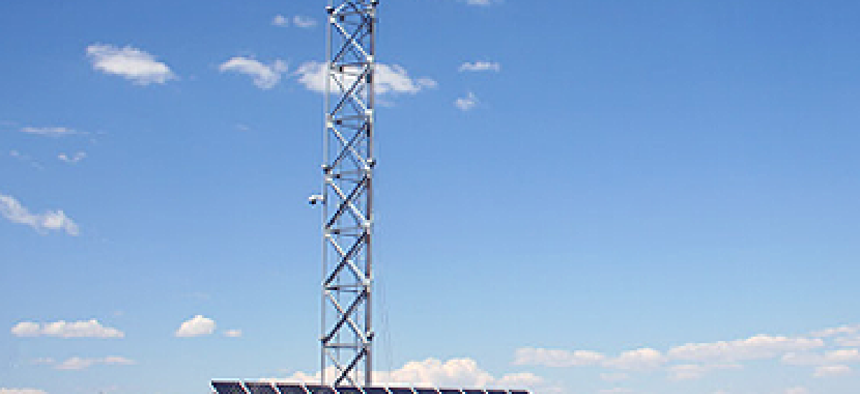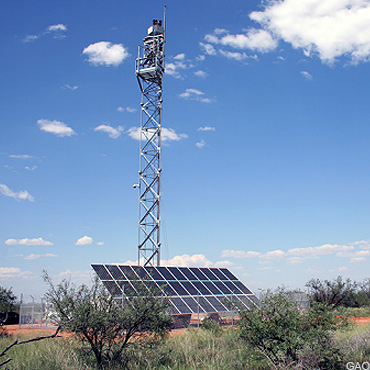Unfilled DHS slots no barrier to border wall effort

Can the Department of Homeland Security focus on the border wall project without permanent leaders in key spots?

A sensor array guarding the U.S.-Mexico border.
The Department of Homeland Security is led by an acting secretary and key component jobs remain unfilled, but expert observers say a lack of Senate-confirmed leaders won't be a significant obstacle to the border wall projects.
Funding for the wall is likely to be a flash point for upcoming budget discussions on Capitol Hill. Congressional Democrats say they won't budge on funding, and their votes are needed in the Senate.
Many Republicans are unenthusiastic about the wall, and a few are outright opposed to the project -- for reasons ranging from property rights to costs to technology and immigration policy.
In an Aug. 22 speech in Phoenix, President Donald Trump said he would veto an appropriations package and shut down the federal government if Congress didn't include funding for the construction of the project.
"If we have to close down our government, we're building that wall," said the president, who has asked for $1.6 billion to build a portion of the project in his fiscal year 2018 budget proposal.
"I don't believe not having a confirmed secretary or CBP commissioner will make a difference in the wall issue," Gil Kerlikowske, former Customs and Border Protection commissioner under President Barack Obama told FCW in an email on Aug. 23.
Kerlikowske said the White House has put experienced hands on border issues into acting political jobs and senior executive roles. Former DHS Secretary John Kelly was named White House Chief of Staff in late July. Elaine Duke stepped into Kelly's job at DHS as acting secretary, where she remains.
Kevin McAleenan, nominated as CBP commissioner in the spring, has long experience on border issues and is awaiting confirmation in the Senate.
"With John in the White House and both Elaine and Kevin known and trusted leaders, the lack of confirmation should not interfere," Kerlikowske said.
David Bier, an immigration policy analyst at the Cato Institute's Center for Global Liberty and Prosperity, agreed. Bier noted that Kelly is respected on Capitol Hill from his past work as Marine General and as DHS Secretary.
Even so, according to Brandon Behlendorf, assistant professor at the University at Albany's College of Emergency Preparedness, Homeland Security & Cybersecurity, the continued lack of permanent top leadership could slow down DHS if the positions are left open for much longer.
"Acting personnel can still promote the budget at hand; the question is who is preparing next year's priorities?" said Behlendorf. The Senate, he argued, should convene confirmation hearings immediately when it returns from recess and the White House should name a successor to Kelly to plan DHS and CBP's next steps.
Kelly is already on record as telling Congress that a border wall won't be "a physical barrier from sea to shining sea."
As Congress faces a series of imminent fiscal deadlines, support for wall funding could hinge on whether supporters can identify a more tech-savvy approach.
"The combination of fencing -- something that was always being improved and expanded -- and technology, all of which has been advocated by Kelly, may be an answer," said Kerlikowske.
A more tech-driven approach to the wall has taken hold at DHS.
In a background call with reporters ahead of Trump's visit to Phoenix on Aug. 22, DHS officials said they see the wall as a combination of physical barriers and technology.
"A wall in and of itself will not give the agents the protection that they need to work safely in that space, and it won't necessarily protect the border any better," said one official quoted by news reports. Sensors, physical barriers, roads, equipment and intelligence are keys for border security, the official said.
Rep. Will Hurd (R-Texas) introduced a bill in late July that would mandate DHS deploy technology where it is the best option and would prevent funding for construction until a comprehensive border strategy, including a cost estimate and justification, is submitted to Congress.
Hurd has suggested that adding off-the-shelf technology solutions to replace physical walls along the border could save up to $32 billion, cutting the $24.5 million per mile cost of a physical wall to less than $500,000 per mile using a tech-heavy "smart wall."
Sen. John Cornyn (R-Texas) also has pushed to expand the idea of a physical wall along the border to include substantial technological components, especially in environmentally sensitive areas there. His "Building America's Trust Act" would implement technology where DHS deems it more operationally effective than a physical barrier.
Kelly's new position at the White House may give him the president's ear, but there are other voices that could also influence the balance of technology and physical barriers at the border, according to Kerlikowske.
"He staked out a position -- fencing, technology," said Kerliskowske. "It really depends now on how much the president pushes both in terms of money and a real wall. John seemed to thread the needle with Congress and the president, but [Trump's] remarks in Phoenix and the push from Breitbart may change that," he said.
Ultimately, predicted Bier, Congress and the White House will likely come to some sort of last-minute agreement on the wall that includes a variety of technology and physical barriers.
"It's going to be an 'all-of-the-above' kind of solution," he said. "They can all declare victory and walk away."
NEXT STORY: McCain slams slow pace of cyber policy





